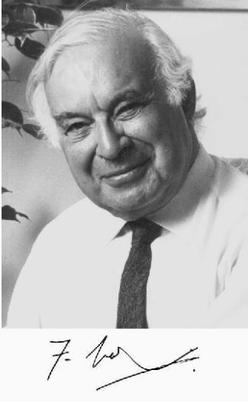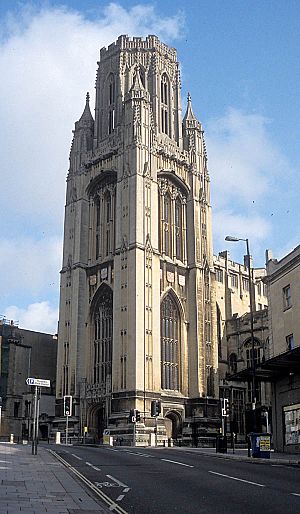Frank Nabarro facts for kids
Quick facts for kids
Frank Nabarro
|
|
|---|---|

Frank Nabarro
|
|
| Born |
Frank Reginald Nunes Nabarro
7 March 1916 |
| Died | 20 July 2006 (aged 90) |
| Known for | Peierls–Nabarro stress Nabarro–Herring creep |
| Awards | Beilby Medal and Prize (1949) Fellow of the Royal Society (1917) |
| Scientific career | |
| Fields | Solid-state physics |
| Institutions | University of Birmingham University of Bristol University of the Witwatersrand |
| Academic advisors | Nevill Francis Mott |

Frank Reginald Nunes Nabarro (March 7, 1916 – July 20, 2006) was an important physicist. He was born in England but became a South African citizen. He was one of the first people to study solid-state physics. This field of science helps us understand how materials work. It is very important for much of today's technology.
Contents
Becoming a Scientist
Frank Nabarro was born in London, UK, on March 7, 1916. His family was Sephardi Jewish. He went to Nottingham High School. Later, he studied at New College, Oxford. He earned top degrees in physics in 1937 and mathematics in 1938.
He then worked at the University of Bristol. There, he studied with Professor Nevill Francis Mott. Professor Mott later won a Nobel Prize in physics. Frank Nabarro quickly became a leader in understanding how crystals break and bend. He wrote many important papers that scientists still use today.
Military and University Work
When World War II started, Nabarro helped defend London from air attacks. He joined a special army group that used science to solve problems. His work on how explosions affect things earned him an award called the MBE.
After the war, from 1945 to 1949, Nabarro was a researcher at the University of Bristol. He then became a teacher of metallurgy (the study of metals) at the University of Birmingham. He earned another high degree from the university in 1953.
In 1953, he moved to Johannesburg, South Africa. He became a professor and head of the physics department at the University of the Witwatersrand. He worked hard to make the department stronger. He wanted it to focus on the physics of solids. This helped the university work better with local industries.
Studying Metals
Nabarro made the physics department at Wits University one of the best in South Africa. He focused his own research on "creep." This is when metals slowly fail or change shape under constant pressure. He also studied "crystal dislocations." These are tiny flaws in the structure of metals that cause them to deform.
He helped the department grow by hiring new scientists. This allowed them to study many different areas. These included magnetic resonance spectroscopy, low-temperature physics, and nuclear physics.
Nabarro made important discoveries about how metals behave. He helped explain why metals change shape under stress. He also improved ideas about how much force is needed to move a tiny flaw in a perfect metal. This idea is now called the Peierls–Nabarro force. His work helped scientists understand how to make stronger materials.
Helping the University and Fighting Apartheid
Frank Nabarro also served as a leader at the University of the Witwatersrand. He was in charge of planning for the university's future. This included hiring staff and organizing academic programs.
From 1978, the university planned to allow students of all races to enroll. This was a big change because of apartheid, which kept races separate. Professor Nabarro led the team that planned for this. He had to figure out how many new students would come. He also planned how to fit them all into classes and dorms.
His team predicted that many more Black students would join the university. They also realized that these students might need extra help. This was because of the poor education many received under apartheid. Nabarro helped set up programs to support these students. These programs helped with subjects like math, science, and English.
Frank Nabarro was strongly against apartheid. He worked hard to allow all students, no matter their race, to attend South African universities. When apartheid finally ended in the 1990s, he helped manage the large number of new students. These students were now able to attend universities that were once only for white students.
He was one of the first members of the South African Institute of Physics. He stayed a strong supporter of their work to promote physics in South Africa.
Frank Nabarro married Margaret Constance Dalziel in 1948. They had three sons and two daughters. Margaret passed away in 1997.
Other Interests
Frank Nabarro loved to share his passion for physics. He often invited university students to his home for lively discussions. He also enjoyed reading books by Marcel Proust. He and his wife, Margaret, shared a deep love for classical music. Margaret was a well-known expert in the study of music from different cultures. Frank Nabarro was the Honorary President of the Johannesburg Musical Society. He also started a special fund for music concerts in memory of his wife.
Awards and Honors
Frank Nabarro received many awards for his important work:
- MBE (1946)
- Beilby Medal and Prize (1949)
- Fellow of the Royal Society (1971)
- Medal of the South African Association for the Advancement of Science (1972)
- Honorary Fellow of the Royal Society of South Africa (1973)
- De Beers Gold Medal, South African Institute of Physics (1980)
- Claude Harris Leon Foundation Award of Merit (1983)
- J F W Herschel Medal, Royal Society of South Africa (1988)
- Honorary Member, South African Institute of Physics (1991)
- CSIR Fellow, South Africa (1994)
- AIME R F Mehl Award (1995)
- Founder Member, Academy of Science of South Africa (1995)
- Foreign Associate, US National Academy of Engineering (1996)
- Institute of Materials Platinum Medal (1997)
- Honorary Member, Microscopy Society of Southern Africa (1998)
- Honorary President, Johannesburg Musical Society (1999)
- Order of Mapungubwe in Silver (2005)
Books by Frank Nabarro
- Physics of Creep and Creep-Resistant Alloys – F. R. N. Nabarro and H. L. de Villiers
- Theory of Crystal Dislocations (Dover Books on Physics and Chemistry) – F. R. N. Nabarro
- Dislocations in Solids : Ordered Alloys (Dislocations in Solids) – F. R. N. Nabarro and M. S. Duesbery
- Dislocations in Solids, Volume 12 (Dislocations in Solids) – F. R. N. Nabarro (editor John Price Hirth)

